Dental Implants Restorations
PATIENT REVIEWS
What are Dental Implants?
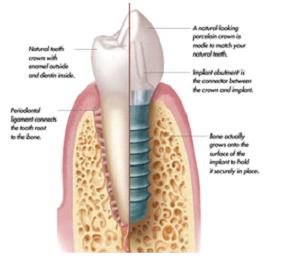
A dental implant is an artificial tooth root that is placed into the jaw to hold a replacement tooth or teeth. Dental implants are an ideal method of tooth replacement for people in good general health who have lost a tooth or teeth due to an accident, periodontal disease, severe decay or some other reason.
- Titanium, bone-integrated implant
- Implant abutment
- Implant porcelain crown
Dental Implants became popular in the late 1980’s in the United States and Dr. Edalat was at the time a tenured clinical professor at New York University College of Dentistry which gave him the opportunity to be in the hub of Dental implants research and advancements. The vast experience and knowledge that his team possesses from nearly 40 years of teaching and clinical cases distinguishes this team and is a source of confidence for their patients who realise the complex nature involved in dental implant procedures and the importance of working with certified professionals in this dynamic field.
The following are advantages of replacing missing teeth with dental implants :
- Maintain the volume and density of the available bone after tooth loss. research and clinical studies have shown that if an implant is not placed after tooth loss, the jaw bone where the tooth is missing will continue to atrophy just like a muscle might if it is not in use, meaning there will be bone loss due to what is called disuse atrophy. Putting implants in place of a missing tooth or teeth will ensure that the bone is stimulated and under use therefore the volume and density of bone is maintained. Since the bone is maintained the facial muscles are also maintained in their healthy natural appearance, therefore the patient will not show the signs of precocious aging that is most often seen with denture wearers such as exaggerated para labial folds and wrinkles.
- Practicing the biomimetic approach by preserving the health of the adjacent teeth- Since there is no need for crown and bridge work, the neighboring teeth are not altered and reduced in size, therefore there are none of the potential associated complications seen with crown and bridges such as tooth sensitivity, tooth decay , root canal therapy and even possible tooth loss due to the above mentioned risks and complications.
- Improved ability to speak, eat and smile in comfort and confidence, thus improving both the social and professional life of the individual.
- eliminate the use of one of the most uncomfortable prosthesis in dentistry which are the full and partial dentures. For fully edentulous patients there is an option to wear a denture but one that is “locked in” to implants placed in the jaw, so that the dentures are secure, therefore there is no need to use adhesive pastes to keep the implants in place. One of the most significant benefits of restoring missing teeth with implants instead of dentures is the individual is able to chew more efficiently using heavier bite forces, thus being able to maintain a healthier well balanced diet such as foods that are harder to eat with a denture such as meats and vegetables and consuming less softer foods like carbohydrates which may lead to obesity. Therefore, the often associated symptoms of malnutrition seen by most denture wearers is eliminated and the life expectancy of the individual is improved.
- compared to traditional dentures, Implants look and feel more like natural teeth thus improving the facial profile and overall face dental aesthetic composition.
In Dr. Edalat’s dental studio Cosmetic Dental Specialties they have been successfully placing implants and restoring smiles since 1982 . The procedure is done under local anesthesia and if necessary, the patients use conscious sedation, which is a state of sedation characterized by a minimally depressed consciousness where the patient remains responsive but more relaxed and comfortable during the procedures.
PATIENT EDUCATION VIDEOS
Diagnosing Bone Loss

Before and after photos showing the missing central incisor replaced by an implant restoration.
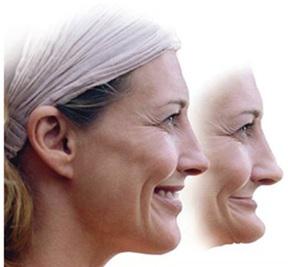
The photo above demonstrates severe bone loss after multiple missing teeth: facial disfigurement accompanied by the appearance of premature aging. Dr. Edalat’s SMILE REJUVENATION TREATMENTS reverses the again process by restoring the bone loss and tooth loss. The SMILE REJUVENATION TREATMENTS restores the faciodental composition and harmony, thus reversing the aging process. The goal is to redefine a smile line that matches the unique character and personality of the patient.
The harmonious aesthetic integration is a subjective matter which varies from person to person in relation to the patient’s smile, face shape, age, and character.
Losing a tooth can be devastating, not only because it affects the way you look, but also because it can lead to other physical problems that may affect your health and prevent you from smiling with confidence.
It is vitally important to replace missing teeth with dental implants promptly in order to prevent health consequences such as:
- Bone loss
- Psychological effects of tooth loss such as depression and anxiety
- Shifting and drifting of the adjacent teeth
- Alteration in the bite as a result of shifting teeth
- Jaw joint problems including pain, discomfort, headaches, neck aches, limited jaw opening, among others.
- Difficulty in chewing properly which may cause malnutrition and subsequent decreased life expectancy along with increased risk for systemic diseases such as obesity, high blood pressure, diabetes, heart disease, stroke, etc….
- Additional stress on the remaining teeth, with potential bone loss around the remaining teeth over time.
- Social life and professional life may be affected.
PATIENT EDUCATION VIDEOS
Bridges vs. Implants
For many patients dental implants offer clear advantages over traditional bridgework or dentures. Before dental implants were perfected, in order to replace missing teeth we had to restore the missing space with tooth-supported bridges or removable dentures. With bridges, healthy tooth structure has to be ground away by reshaping neighboring teeth, which allowed us to use them as supports for anchoring the new bridge. Unfortunately, these support teeth may be subjected to forces beyond their physiologic threshold, so the bone surrounding these teeth may begin to resorb causing more tooth loss over time, creating a domino effect. However, there are certain cases which may be advantageous to restore the missing teeth with conventional bridges instead of dental implants. Dr. Edalat communicates in details about the different treatment options and explains carefully the advantages and disadvantages of each treatment option. Like this the patient can make an informed and educated decision along with the doctors help as to the ideal treatment plan for their particular case. This is one of the differentiating benefits of being treated by Dr. Edalat’s team
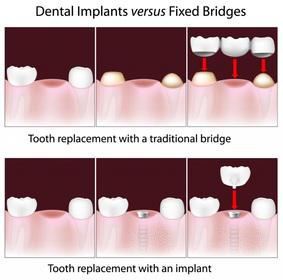
 Single tooth implant restoration
Single tooth implant restoration
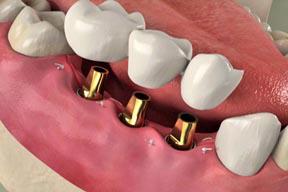
An important factor to obtain optimal results and long term success is the choice of the dental prosthetic laboratory that the dentist employs. Dr. Edalat has been working with internationally recognised master ceramists and dental technicians which play a vital role in the success of each individual treatment, both aesthetically and functionally. Using detailed communication with photographs, videos and in lab visits with the patient, the triad team of dentist, patient and dental technicians are able to achieve optimal results and minimise complications in the long term.
Three missing anterior teeth being replaced by a two implant restoration

An implant restoration replacing the missing maxillary lateral incisor
Prior to starting any major restorative work it is most important for the dentist to create a well established and detailed sequence of the Ideal Treatment Plan: Depending on the complexity of the case it may take several days for the doctor to study, analyse and create the ideal treatment plan. Using diagnostic tools such as conventional radiographs, CAT scans which are three dimensional computerised radiographs, study models and aesthetic wax ups of the desired final result the ideal treatment plan is established. Dr. Edalat explains in detail the advantages and disadvantages of each treatment option so the patients can make an educated and informed decision as to which treatment plan is more suitable for their particular case. Since there are more than 54 variables which will determine the ideal treatment plan this stage is crucially important to guarantee the success of the treatment rendered and minimise any potential complications which are inherent with any implant system.
Once the ideal treatment plan is decided by the doctor and patient the next step is to restore the available bone volume and density prior to placing any implants. Since the surrounding bone is the foundation of the implants and will determine the functional and aesthetic success of the treatment rendered. It is common to perform various bone graft surgeries and plastic surgeries of the gums prior to or in conjunction with placing implants. This is another outstanding differentiating factor of Dr. Edalat’s team as they are certified specialists in both the surgical and prosthetic aspects of dentistry, with all procedures being performed in the same office by the same family team, this improves the success of the treatments since the communication is enhanced by the family team, thus there is less chance of miscommunications between dental specialists working from different offices.
Once the available bone is ideal in volume the implants may be surgically placed and they are allowed to heal and integrate with the bone over a 4-8 month period depending on the complexity of the case. In some cases the implant may be immediately loaded after being surgically placed in the bone. Since immediate loaded implants may have a higher failure rate the case must be carefully studied in detail by Dr. Edalat.
Once the implant has healed with the bone the restorative phase can begin with the placement of an abutment pillar on the implant and over the next few visits eventually placing the tooth (porcelain or ceramic crown) on the pillar.
Additional plastic surgeries of the gums or bone grafting surgeries may be necessary to enhance the aesthetic final result or functional aspect of the implant system. In such cases the patient will be advised of additional treatments and costs involved.
Once the treatment is completed Dr. Edalat’s team advises the patients on the importance to return for maintenance visits, regular cleanings and preventive check ups to ensure the balanced harmony of the implant system and its success for the long term.
PATIENT EDUCATION VIDEOS
Alternatives to Implants Partially Edentulous

Shifting teeth caused by tooth loss


Treatment alternatives
When you’re missing one or more teeth, you have several choices for replacing them:
- Wear a partial denture
- Wear a bridge
- Delay treatment
- Wear an implant-supported crown or bridge
Wearing an implant-supported crown or bridge
Unlike partial dentures and bridges, an implant replaces the roots of missing teeth, so it helps maintain the health and shape of the jawbone. An implant holds natural-looking crowns and bridges securely in the mouth without requiring clasps or reducing neighboring teeth. This enables you to talk and chew easily, and it preserves your beautiful smile.
Wearing a partial denture
A partial denture can replace one or more missing teeth. A partial is held in place by clasps or special attachments, and it is removable for sleeping and cleaning.
Wearing a bridge
A bridge might also be an alternative. There are several types, but they are all permanently anchored to neighboring teeth. This requires us to reduce the anchoring teeth, even if they are healthy, and reducing healthy teeth can sometimes lead to decay and root canal therapy.
Delaying treatment
If you are thinking about delaying treatment, you should know that without teeth and tooth roots, the jawbone in that area gradually shrinks. This weakens the jaw and changes your appearance. The longer you delay, the more the jawbone will shrink, making future treatment more complex.
In addition, teeth need each other for support. Missing teeth can lead to a chain reaction of dental problems, including shifting teeth, increased risk for tooth decay and periodontal disease, and changes in the bite that can lead to painful problems with your jaw joints.
PATIENT EDUCATION VIDEOS
Alternatives to Implants Full Arch
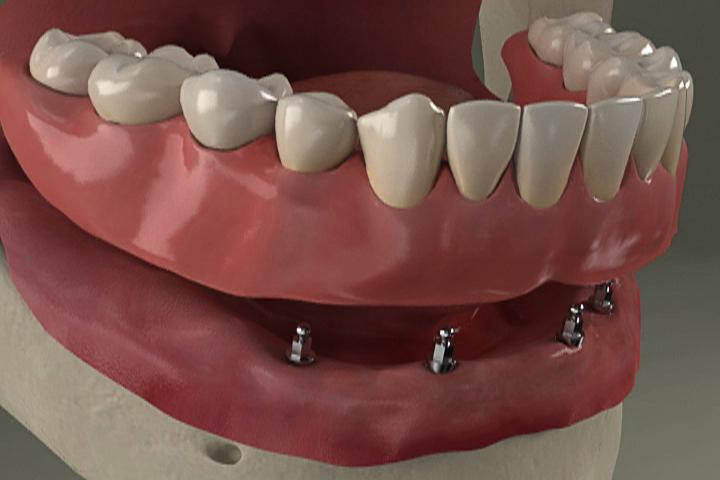
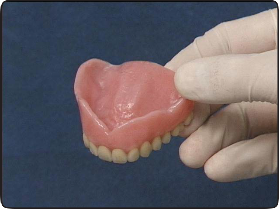
Treatment alternatives
When you are missing a full arch of teeth, you have several choices for replacing them:
- Modify a current denture
- Wear a new conventional denture
- Wear an implant-retained denture
- Delay treatment
Modifying a current denture
If you now wear a denture that does not fit well, we may be able to adjust or reline it so that it is more comfortable and functional. Sometimes we can create a better-fitting denture base, reusing the teeth in your current denture.
Wearing a denture
If you have not worn a complete denture before, or if your old one needs replacing, we can create a new denture for you.
Dentures can look good and fit well at the start. However, when teeth are missing, the jawbone gradually shrinks, and in some cases, dentures can accelerate bone loss. This shrinkage changes your appearance. It also causes dentures to become loose, making it difficult to chew and talk and causing sores and tender spots to develop.
Wearing an implant denture
An implant denture (fixed denture) is different than a removable denture. An implant denture stays in the mouth, and a removable denture can be taken out of the mouth. Depending on your situation, an implant denture may not be the best choice for you, in which case you have two alternatives to consider: either modify an existing denture or have a new one created.
Delaying treatment
If you are thinking about delaying treatment, you should know that the jawbone will continue to shrink due to the missing teeth. This means that delaying treatment now will make future treatment more complex.
PATIENT EDUCATION VIDEOS
Placing an Implant Bridge
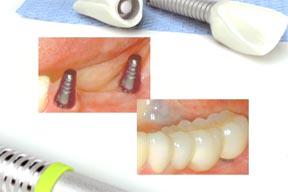

When several neighboring teeth are missing, an implant-supported bridge is an excellent treatment for replacing them.
Although each case will be different, placing an implant-supported bridge generally involves two phases. The first phase is the surgical placement of the implants. The second phase is restoring the implants with the bridge.
The benefits of implants with a bridge
Implants restored with a bridge have several advantages. The implant stops the bone loss that occurs when a tooth is lost, and the bridge prevents the surrounding teeth from shifting into the space. Unlike a traditional bridge, there is no need to reduce the size of neighboring teeth. A bridge retained by implants looks and feels like your natural teeth when you chew and talk.
With proper homecare and regular checkups, your implants can be a long-term solution for a natural-looking smile.
Placing the implants
For the surgical placement of the implants, your mouth is thoroughly numbed. An incision or small openings are made in your gums, and a channel is shaped in the bone to receive each implant.
Next we place the bodies of the implants into the prepared channels. Sometimes covers are placed on the implants, and the gums are stitched closed. This method is called a two-stage procedure. In other cases that allow a single- stage procedure, extensions are attached to the implants at the time of the surgery.
Healing may take several months as the implants become fused securely to the bone. During this time, we may place a temporary replacement bridge.
Restoring the implants with a bridge
If the first phase included closing the gums over the implant, the second phase starts with surgical re-exposure of the implant. Small incisions are made in your gums, and an extension is placed on each implant to bring it above the gumline. Then we schedule a series of appointments to create your final bridge.
Though some of the steps might be different in your case, they usually include removing a temporary bridge and taking impressions of your mouth. The lab uses the impressions to make an accurate model of your mouth, including the implants. They use the model to create a bridge that fits the implants and your bite.
Depending on the circumstances, we may have you try in the bridge framework, or we have you try in the final bridge. When everything is right, we secure your beautiful new bridge to the implants.
PATIENT EDUCATION VIDEOS
Implant Immediate Placement Procedure
 Implant with immediate crown placement
Implant with immediate crown placement


When a tooth must be extracted, we can sometimes place an implant in the socket immediately after the tooth has been removed.
Although each case will be different, placing the implant immediately after an extraction generally involves two phases, placing the implant in the socket and securing a restoration, such as a crown or bridge, onto the implant.
The benefits of immediate placement
An immediately placed implant has several advantages. Extraction and implant placement can occur during the same procedure. The implant stops the bone loss that normally occurs when a tooth is lost, and it prevents the surrounding teeth from shifting into the space. And unlike replacing a tooth with a traditional bridge, there is no need to reduce the size of neighboring teeth. The implant with its restoration looks and feels like your natural teeth when you chew and talk.
Placing the implant
First we make sure the area is completely numb, and then we remove the tooth. We reshape the extraction site and place the body of the implant into the prepared socket. In many cases, we add bone grafting material to the socket to help the jawbone heal tightly around the implant.
A healing cap or an extension is attached to the implant. We then close the gums. Over the next several months, the implant will become fused securely to the bone. During this time, we may place a temporary replacement tooth.
Restoring the implant
The next phase includes a series of appointments to create your final restoration. Though some of the steps might be different in your case, they usually include removing the temporary and making impressions of your mouth.
The lab uses the impressions to make an accurate model of your mouth, including the implant. They use the model to create a restoration that precisely fits the implant and your bite.
When your beautiful new restoration is ready, we check the fit and your bite and then secure it to the implant.
With proper homecare and regular checkups, your implant can be a long-term solution for a natural-looking smile.
PATIENT EDUCATION VIDEOS
Placing Implant Overdentures Lower Jaw




When all the teeth in an arch are missing, an excellent treatment for replacing them is a denture secured with implants.
Depending on your situation, the denture may snap onto the implants in your jaw, or it may clip to a bar that is attached to the implants. These systems keep the denture secure in your mouth, but allow you to remove it when necessary.
Although each case will be different, placing an implant-retained denture generally involves two phases. The first phase is the surgical placement of the implants. The second phase is fitting the dentures over the implants.
The benefits of a denture retained by implants
Dentures attached to implants have several advantages. The implants slow or stop the loss of jawbone that occurs when teeth are missing. The dentures are stable in the mouth, which makes it more comfortable to talk and chew. And the dentures are removable for easier cleaning and checkups.
With proper homecare and regular checkups, your implant-retained denture can provide a secure and natural-looking smile.
Placing the implants
For the surgical placement of the implants, your mouth is thoroughly numbed. Small openings are made in your gums, and then a channel is shaped in the bone to receive each implant.
Next, we place the bodies of the implants into the prepared channels. Covers are placed on the implants, and the gums are often stitched closed. During the healing period, you might wear a temporary denture, or your own denture may be modified to fit over the implants. Healing may take several months as the implants become fused securely to the bone.
Fitting dentures over the implants
The next phase starts with a series of appointments to create your final denture. Though some of the steps might be different in your case, they generally begin with gently exposing the implants. Then we take impressions and bite registrations of your mouth.
The lab uses these records to make an accurate model of your mouth, including the implants. They use the model to create a final denture that precisely fits the implants and your bite.
After the denture is complete, we place it onto the implants, check the fit and your bite, and you have your beautiful final denture.
PATIENT EDUCATION VIDEOS
Implants Overdentures Upper Procedure
 Implant overdenture with abutment for attaching overdenture
Implant overdenture with abutment for attaching overdenture


When all the teeth in an arch are missing, an excellent treatment for replacing them is a denture secured with implants.
Depending on your situation, the denture may snap onto the implants in your jaw, or it may clip to a bar that is attached to the implants. These systems keep the denture secure in your mouth, but allow you to remove it when necessary.
Although each case will be different, placing an implant-retained denture generally involves two phases. The first phase is the surgical placement of the implants. The second phase is fitting the dentures over the implants.
The benefits of a denture retained by implants
Upper dentures retained by implants have several advantages. The implants slow or stop the loss of jawbone that occurs when teeth are missing. The dentures are stable in the mouth, and often they can be shaped so they don’t cover the palate. This makes it easier to talk, chew, and taste your food. And the dentures are removable for easier cleaning and checkups.
With proper homecare and regular checkups, your implant-retained denture can provide you with a secure and natural-looking smile.
Placing the implants
For the surgical placement of the implants, your mouth is thoroughly numbed. Small openings are made in your gums, and then a channel is shaped in the bone to receive each implant.
Next, we place the bodies of the implants into the prepared channels. Covers are placed on the implants, and the gums are often stitched closed. During the healing period, you might wear a temporary denture, or your own denture may be modified to fit over the implants. Healing may take several months as the implants become fused securely to the bone.
Fitting dentures over the implants
The next phase starts with a series of appointments to create your final denture. Though some of the steps might be different in your case, they generally begin with gently exposing the implants. Then we take impressions and bite registrations of your mouth.
The lab uses these records to make an accurate model of your mouth, including the implants. They use the model to create a final denture that precisely fits the implants and your bite. After the denture is complete, we place it onto the implants, check the fit and your bite, and you have your beautiful final denture.
PATIENT EDUCATION VIDEOS
Post Op Instructions for a Fixed Implant
 Cleaning aids
Cleaning aids


Protecting your implants
Now that final restorations have been placed on your implants, it’s important to follow these recommendations to ensure their success.
Avoid using any tobacco products. Ideally, you should quit altogether because tobacco slows healing and increases the risk that your body will reject the implants. Tobacco is the leading cause of implant failure.
Avoid grinding and clenching your teeth because this can damage the implants and restorations. If grinding and clenching continue to be a problem, we may need to adjust the restorations or have you wear a nightguard.
Chewing and eating
If we used anesthetic during the procedure, avoid chewing until the numbness has worn off completely.
To protect your implants and restorations, avoid chewing ice and other hard objects.
Brushing and flossing
Brush and floss around your implants thoroughly but gently. We may recommend special floss, brushes, mouthrinses, or other cleaning aids to keep the area free of bacteria.
Brush and floss your gums and natural teeth normally.
Medication and discomfort
Take antibiotics or other medications only as directed.
To reduce discomfort or swelling, rinse your mouth three times a day for two weeks with warm salt water. Use about one teaspoon of salt per glass of warm water. It’s normal for your gums to be sore and swollen for a few days.
When to call us
Call us if your bite feels uneven or your restorations feel loose, so we can adjust them. Also call us if you have persistent swelling or discomfort, or if you have any questions or concerns.
One of the keys to Dr. Edalat’s outstanding dental practice is the careful selection of his dental prosthetic laboratory which is responsible for half of any restorative work. The internationally recognised works of Dr Edalat’s master ceramist are the fruit of more than 20 years of dedication practicing and teaching at prestigious dental schools internationally, catering to the elite dental professionals and their most demanding patients, and coauthoring books on the advanced aesthetic techniques. Members of the prestigious Oral Design International Foundation, The American society for Dental Aesthetics, and the Dental Laboratory Association of New York. Recognised as one of the preeminent instructors of advanced oral design techniques in the world. Director and clinical professor at the prestigious New York University College of Dentistry continuing dental education course entitled “ Mastering Aesthetics and ceramics”.
PATIENT EDUCATION VIDEOS
Post Op Instruction for a Removable Implant
The cost of any dental treatment varies depending on several factors such as : The experience, technical knowledge and artistic sensitivity/talent of the dentist, his master ceramist and dental technicians involved. Also the dental materials which are used including the manufacturer of the dental implants and its different acessories, and the material used by the dental laboratory such as the type of metals and ceramics employed. Finally the perceived value of the doctors work and his lab technicians also determine the price range of the proposed treatment. Therefore it is important for the patient to take into consideration the above mentioned variables when deciding on the dental professional they choose to trust for their oral health care.
Homecare-Implant Removable Restoration
Now that you’ve received your implant-retained denture, it’s important to follow these recommendations to ensure its success.
Chewing and eating
If we used anesthetic during the procedure, avoid chewing until the numbness has worn off completely.
To protect your implants and denture, avoid chewing ice or other hard objects.
Brushing and flossing
Brush your implants with a soft toothbrush, and floss them thoroughly every day. We may recommend special floss, brushes, mouthrinses, or other cleaning aids to keep the area free of bacteria.
Brush and floss your tongue, gums, palate, and any remaining teeth twice a day to keep them free of plaque and bacteria.
Caring for your denture
To keep your denture free of plaque, rinse it with cool water after every meal. Thoroughly clean all surfaces of the denture with a denture brush and a commercial denture cleaning product at least once a day. It’s important to keep dentures clean to prevent irritation, permanent staining, and bad breath.
We may ask you to remove your denture for sleeping, or for at least six to eight hours a day. Store your denture in cool water whenever it’s out of your mouth. You can also soak your denture in a commercial soaking solution. After soaking, rinse dentures in cool water.
When to call us
Call us if your bite feels uneven, your dentures become loose, you have persistent swelling or discomfort, or you have any questions or concerns.
PATIENT REVIEWS
My husband and I both needed extensive dental work…and so, we actually flew to New York to see Dr. Edalat, after meeting one of his students who had raved about Dr. Edalat and his office. Both my husband and I feel and look so much better after our treatment. We wouldn’t dream of seeing any other dentist ever again!”
Louise C. – Kent, England

 Google
Google Yahoo
Yahoo Yelp
Yelp Insider Pages
Insider Pages Healthgrades
Healthgrades CitySearch
CitySearch Wellness
Wellness




